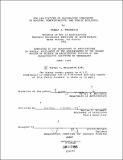| dc.contributor.advisor | Waclaw P. Zalewski. | en_US |
| dc.contributor.author | Beroukhim, Farnaz A | en_US |
| dc.contributor.other | Massachusetts Institute of Technology. Dept. of Architecture. | en_US |
| dc.date.accessioned | 2012-07-02T15:20:52Z | |
| dc.date.available | 2012-07-02T15:20:52Z | |
| dc.date.copyright | 1985 | en_US |
| dc.date.issued | 1985 | en_US |
| dc.identifier.uri | http://hdl.handle.net/1721.1/71362 | |
| dc.description | Thesis (M.S.)--Massachusetts Institute of Technology, Dept. of Architecture, 1985. | en_US |
| dc.description | MICROFICHE COPY AVAILABLE IN ARCHIVES AND ROTCH. | en_US |
| dc.description | Includes bibliographical references (leaves 71-72). | en_US |
| dc.description.abstract | Standard prestressed hollow-core slabs have many advantages as construction members while being relatively very low in cost. The principal advantages include the ease of mass production, a small cross-sectional area, light weight, and flat surfaces. In addition, the slabs have the advantage s of concrete, precasting and prestressing. The only specifications which make hollow-core components unsuitable for wall members are their lack of weight and mass, their inability to be used as long members because of the limited distance between the floor-to-floor height, and, in some cases, insufficient insulating qualities. This thesis recommends a practical and economical system for the structural use of hollow-core components which have been modified with two other additional structural members - a continuous precast "L" beam and a precast support panel. This system will allow a high degree of standardization and an additional saving in the total cost of the equipment and formworks. Most of all, the wall members have the advantages of precast prestressed hollow-core slabs and their low cost. The new system's applications are mainly directed towards housing, administrative and public buildings. A design example is also introduced and analyzed in terms of possible variations in area of the individual units and the total cost of the building . The latter case shows that the total cost of structure per square-foot for the recommended system is considerably lower than the other construction types. | en_US |
| dc.description.statementofresponsibility | by Farnaz A. Beroukhim. | en_US |
| dc.format.extent | viii, 72 leaves | en_US |
| dc.language.iso | eng | en_US |
| dc.publisher | Massachusetts Institute of Technology | en_US |
| dc.rights | M.I.T. theses are protected by
copyright. They may be viewed from this source for any purpose, but
reproduction or distribution in any format is prohibited without written
permission. See provided URL for inquiries about permission. | en_US |
| dc.rights.uri | http://dspace.mit.edu/handle/1721.1/7582 | en_US |
| dc.subject | Architecture. | en_US |
| dc.title | New applications of hollow-core components in housing, administrative and public housing | en_US |
| dc.title.alternative | Hollow-core components in housing, administrative and public buildings, New applications of | en_US |
| dc.type | Thesis | en_US |
| dc.description.degree | M.S. | en_US |
| dc.contributor.department | Massachusetts Institute of Technology. Department of Architecture | |
| dc.identifier.oclc | 13150066 | en_US |
